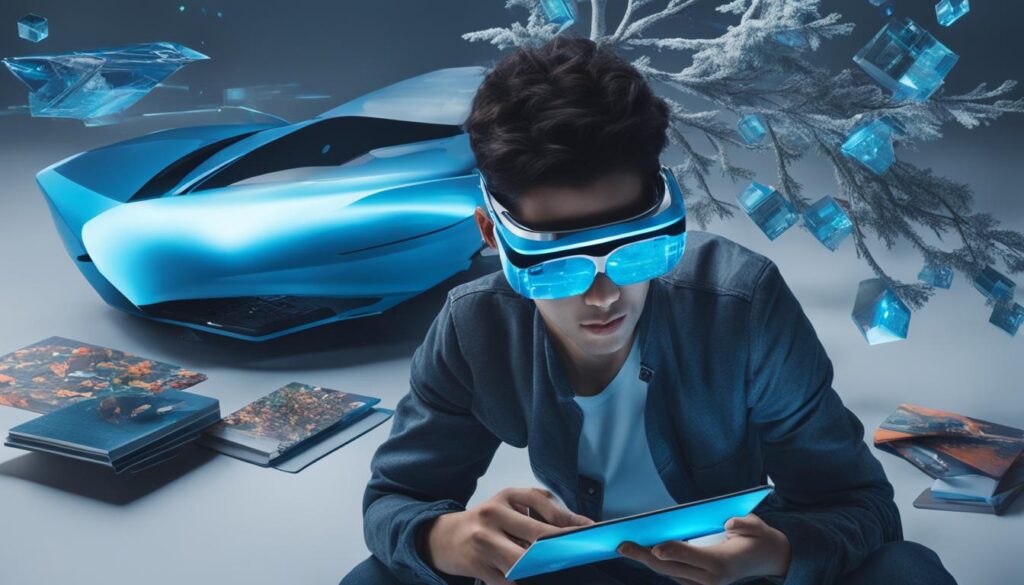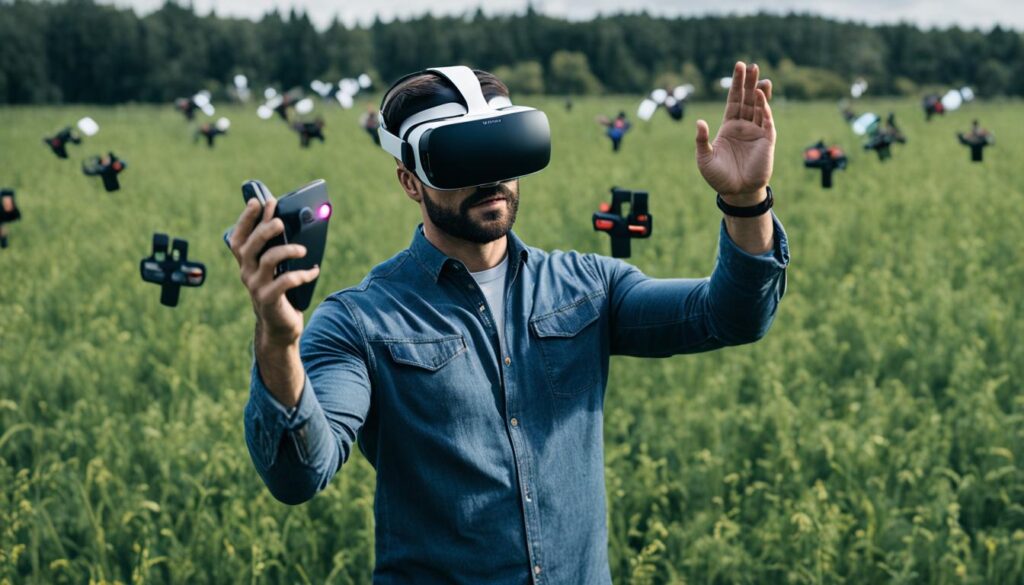Augmented reality (AR) is a rapidly growing field that offers exciting career opportunities. To embark on a successful journey in AR, it’s crucial to equip yourself with the right skills and technology. Let’s explore the essentials required to make augmented reality technology work.
Contents
- 1 Programming Skills for Augmented Reality
- 2 3D Modeling and Graphic Design for Augmented Reality
- 3 AR Game Design and Industrial Design
- 4 Hiring a Professional Image Processing for AR App Development
- 5 Conclusion
- 6 FAQ
- 6.1 What technology is needed for augmented reality to work?
- 6.2 What programming skills are needed for augmented reality development?
- 6.3 What skills are important for 3D modeling and graphic design in augmented reality?
- 6.4 How can I start a career in AR game design or industrial design?
- 6.5 Are there other career pathways besides development and design in augmented reality?
- 6.6 What equipment and software do I need for VR and AR development?
- 6.7 Should I hire a professional image processing company for AR app development?
- 6.8 What can I do to succeed in the augmented reality market?
- 7 Source Links
Key Takeaways:
- Developing programming skills in languages such as C#, C++, and JavaScript is essential for AR development.
- Skills in 3D modeling and graphic design are crucial for creating visually appealing AR experiences.
- AR game design and industrial design offer unique career pathways within the field.
- Other career opportunities in AR include business management and content development.
- Getting started with VR and AR development requires basic equipment and software.
Programming Skills for Augmented Reality
In order to work with augmented reality (AR) technology, it is essential to have strong programming skills. These skills form the foundation for creating AR applications and working on AR development projects. By mastering programming languages suitable for AR and mobile app development, you can unlock the full potential of AR tech.
Popular programming languages for AR development include:
- C#
- C++
- JavaScript
Proficiency in these languages will enable you to design and implement interactive AR experiences and applications. Whether it’s developing AR games, educational tools, or practical solutions, programming skills play a vital role in bringing AR applications to life.
Programming skills are the building blocks of augmented reality development. By mastering the right programming languages, you can create innovative AR applications that transform the way we interact with technology.
If you’re new to programming or looking to expand your skills, there are various online resources available to help you get started. Udemy and FreeCodeCamp offer courses specifically designed for beginners, providing step-by-step guidance in learning programming languages.
By investing time and effort into developing your programming skills, you can become proficient in AR development and contribute to the exciting world of AR applications.
Benefits of Programming Skills for AR Development
Having strong programming skills opens up numerous opportunities in the field of augmented reality development. Here are some key benefits:
- Ability to create interactive and immersive AR applications
- Innovative problem-solving for AR development projects
- Collaboration with designers and other developers to bring AR concepts to life
- Flexibility to work on AR projects across different industries
Programming skills empower you to be at the forefront of AR technology, driving innovation and shaping the future of digital experiences.
3D Modeling and Graphic Design for Augmented Reality
Creating visually appealing and immersive experiences in augmented reality (AR) involves having expertise in 3D modeling and graphic design. Understanding the fundamentals of 3D modeling and possessing a keen eye for design are essential skills in this field. You can acquire these skills through online courses, such as those offered by Google’s Udacity program.

Graphic designers who are familiar with tools like Photoshop and Illustrator can leverage their experience to develop 3D models and design user interfaces for AR applications. Combining proficiency in both 3D modeling and graphic design enables you to work seamlessly with a wide range of AR devices, hardware, software, and platforms.
Benefits of 3D Modeling in Augmented Reality
By leveraging 3D modeling techniques, you can create realistic and interactive digital objects that seamlessly blend with the real world in AR. These 3D models enhance the user experience by adding depth, dimension, and interactivity to the virtual elements.
Importance of Graphic Design in AR User Interfaces
Graphic design plays a crucial role in designing intuitive and visually appealing user interfaces for AR applications. By incorporating principles of graphic design, such as visual hierarchy, color psychology, and typography, you can create user interfaces that are user-friendly, aesthetically pleasing, and effective in conveying information.
| AR Devices | AR Hardware | AR Software | AR Platforms |
|---|---|---|---|
| Smartphones | Headsets | AR development tools | ARKit (iOS), ARCore (Android) |
| Tablets | Glasses | AR content creation software | Unity, Vuforia |
| Smart glasses | Cameras | AR tracking and mapping tools | Microsoft HoloLens |
With these skills and knowledge, you’ll be equipped to create compelling and engaging AR experiences that captivate users and push the boundaries of what’s possible in this rapidly evolving field.
AR Game Design and Industrial Design
Augmented reality (AR) offers exciting opportunities for both game designers and industrial designers. In the world of AR game design, you have the chance to create immersive gaming experiences that seamlessly blend virtual objects with the real world. It’s important to understand the unique aspects of AR games compared to traditional video games, as this will inform your design choices and ensure a captivating user experience.
Industrial designers, on the other hand, focus on creating functional and innovative objects that incorporate technology in new and exciting ways. AR provides a whole new canvas for industrial designers to explore and push the boundaries of design. By blending the physical and digital worlds, industrial designers can create products that enhance and transform our everyday lives.
If you’re interested in pursuing a career in AR game design or industrial design, it can be beneficial to start by honing your skills in 3D modeling and graphic design. These foundational skills will provide you with a solid understanding of the digital design process and allow you to bring your ideas to life in AR.
Developing expertise in game design can open doors to exciting opportunities in the world of AR. Whether you’re creating immersive storytelling experiences or crafting cutting-edge gameplay mechanics, being an AR game designer offers endless possibilities for innovation and creativity.
On the other hand, industrial designers can leverage their skills to create everyday objects that seamlessly integrate technology and enhance user experiences. Think of wearable AR devices, smart home products, or even futuristic transportation systems. The possibilities are endless for industrial designers in the age of AR.
Careers in AR game design and industrial design require a strong blend of technical expertise and creative thinking. By embracing these skills and staying up to date with the latest advancements in AR technology, you can pave the way for an exciting and fulfilling career in this rapidly growing field.
Key Points:
- AR game designers create immersive gaming experiences that merge virtual objects with the real world.
- Industrial designers focus on creating innovative products that incorporate technology in new and exciting ways.
- Skills in 3D modeling and graphic design serve as a strong foundation for careers in AR game design and industrial design.
- AR game designers have the opportunity to push the boundaries of storytelling and gameplay mechanics.
- Industrial designers can create products that seamlessly integrate technology and enhance user experiences.
- Embracing technical expertise and creative thinking is crucial for success in AR game design and industrial design.

Comparison of VR Headsets
| VR Headset | Resolution | Field of View | Price |
|---|---|---|---|
| Oculus Rift | 2160×1200 | 110° | $399 |
| HTC Vive | 2160×1200 | 110° | $599 |
| PlayStation VR | 1920×1080 | 100° | $299 |
“Starting small, learning from others, and focusing on user experience are essential tips for successful VR and AR development.”
When getting started with VR and AR development, it’s important to choose the right hardware and software tools. VR headsets like the Oculus Rift, HTC Vive, and PlayStation VR offer immersive experiences and high-resolution displays, allowing users to dive into virtual worlds. On the other hand, AR development requires a camera-enabled device like a smartphone or tablet, alongside an AR development platform such as Unity or Vuforia. These platforms provide the necessary tools and frameworks to create AR applications.
Online Resources for VR and AR Development
- Unity: Offers tutorials, documentation, and a vibrant community for learning VR and AR development.
- Vuforia: A popular AR development platform that provides tools for creating marker-based and markerless AR experiences.
- Coursera: Provides online courses on VR and AR development, covering topics like 3D modeling, programming, and user experience design.
By leveraging these resources and starting with small projects, you can gain valuable experience and build a strong foundation in VR and AR development. Learning from others in the developer community is also crucial, as they can provide insights, tips, and best practices for creating compelling and immersive VR and AR applications. Lastly, always prioritize user experience when designing and developing VR and AR experiences, ensuring that your applications are intuitive, engaging, and user-friendly.
Hiring a Professional Image Processing for AR App Development
Building an AR app requires expertise in image processing and development capabilities. To ensure efficient AR development, it is highly recommended to hire a professional image processing company or agency. Professional agencies specialize in augmented reality app development, offering a wide range of services to meet your specific needs.
When hiring a professional agency for AR development, look for professionals who are skilled in three-dimensional modeling, imaging, and programming languages like C# and C++. These skills are essential for creating high-quality AR experiences and ensuring the success of your app.
In addition to technical expertise, a professional agency can assist you in managing the technical and commercial risks associated with AR projects. They have the knowledge and experience to guide you through the development process, ensuring that your app meets industry standards and delivers a seamless user experience.
“Working with a professional image processing company has been instrumental in the success of our AR app. Their expertise and guidance have helped us create a unique and engaging experience for our users.” – John Smith, CEO
By hiring a professional agency, you can focus on your core business while leaving the technical aspects of AR development to the experts. This allows you to save time and resources, ultimately leading to a more efficient and successful app launch.
| Benefits of Hiring a Professional Image Processing Company for AR Development |
|---|
| 1. Expertise in image processing and AR development |
| 2. Skilled professionals in three-dimensional modeling and programming languages |
| 3. Assistance in managing technical and commercial risks |
| 4. Guidance throughout the AR app development process |
| 5. Time and resource savings |
When it comes to AR app development, partnering with a professional image processing company or agency has numerous benefits. They have the experience, knowledge, and resources to bring your AR vision to life. Don’t hesitate to leverage their expertise for a successful AR app launch.
Conclusion
As augmented reality (AR) and virtual reality (VR) technologies continue to advance, the future market will be shaped by discerning augmented reality consumers who value a seamless user interface (UI) and user experience (UX). To thrive in this rapidly growing AR market, developers must focus on creating intuitive and simple AR applications that meet the expectations of these consumers.
By embracing the necessary skills, such as programming, 3D modeling, and graphic design, and leveraging the right resources, anyone can embark on a career in augmented reality and contribute to the exciting world of AR development. Understanding how to develop a seamless UI and UX is paramount to success in this industry, as it directly impacts user satisfaction and adoption of AR applications.
With the right skills and knowledge, developers can create AR experiences that seamlessly blend the digital and physical worlds, enhancing everyday activities and revolutionizing various industries. Whether it’s optimizing consumer experiences, transforming education, or streamlining business processes, augmented reality has the potential to reshape our lives.
As the AR market continues to evolve, staying up-to-date with the latest technologies, industry trends, and consumer preferences is crucial. By constantly refining their skills and adapting to the changing needs of augmented reality consumers, developers can position themselves for success in this dynamic and promising field.
FAQ
What technology is needed for augmented reality to work?
Augmented reality requires specific hardware, such as smartphones or tablets with cameras, and AR software platforms like Unity or Vuforia.
What programming skills are needed for augmented reality development?
Programming languages like C#, C++, and JavaScript are commonly used for AR development, and proficiency in these languages is crucial for creating AR applications.
What skills are important for 3D modeling and graphic design in augmented reality?
Understanding how 3D models work and having an eye for design are essential skills for creating compelling digital objects in AR. Proficiency in graphic design tools like Photoshop and Illustrator is also valuable.
How can I start a career in AR game design or industrial design?
Starting as a 3D modeler or graphic designer can serve as an entry point into the fields of AR game design and industrial design. Developing skills in game design or industrial design can lead to promising careers in AR.
Are there other career pathways besides development and design in augmented reality?
Yes, there are various other career pathways in augmented reality, including roles such as business managers and content developers.
What equipment and software do I need for VR and AR development?
For VR development, you’ll need a VR headset like the Oculus Rift or HTC Vive, and a powerful computer. For AR development, you’ll need a smartphone or tablet with a camera, as well as an AR development platform like Unity or Vuforia.
Should I hire a professional image processing company for AR app development?
Hiring a professional image processing company or agency can be beneficial for efficient AR app development. They can provide expertise in image processing, 3D modeling, and programming, as well as guidance throughout the development process.
What can I do to succeed in the augmented reality market?
To succeed in the AR market, focus on creating intuitive and simple AR applications that offer a seamless user interface and user experience. Embrace the necessary skills and leverage the right resources to contribute to the exciting world of AR development.




